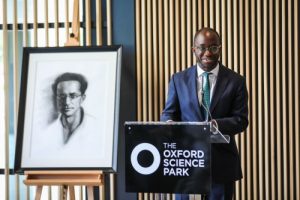- Home
- News
-
Minister of State Sam Gyimah MP to open Schrödinger Building at The Oxford Science Park
Minister of State Sam Gyimah MP to open Schrödinger Building at The Oxford Science Park
05 July 2018
New building part of ongoing investment in development of Park
Oxford, UK, July 5 2018 –
The state-of-the-art Schrödinger Building at The Oxford Science Park,

one of the UK’s leading parks for science and technology companies, is to be opened this afternoon by Sam Gyimah MP, Minister of State for Universities, Science, Research & Innovation. Architecturally inspiring and built to promote collaboration and cross-fertilisation of ideas, the four-storey office and laboratory facility is part of the programme of investment on the Park which has been ongoing since 2016.
The building is named after Prof essor Erwin Schrödinger, recipient of the Nobel Prize for Physics in 1933 and an alumnus of Magdalen College Oxford, which owns The Oxford Science Park.
essor Erwin Schrödinger, recipient of the Nobel Prize for Physics in 1933 and an alumnus of Magdalen College Oxford, which owns The Oxford Science Park.
As well as declaring the Schrödinger Building open, the Minister will hear about the work of 3D technology innovator Fuel3D and Oxford Sciences Innovation, its first two occupiers. A third occupant is expected to be announced shortly.
At 61,500 ft2 (net internal area), the £13m Schrödinger Building is the largest speculative Grade A office building to be developed on The Oxford Science Park and the first new building on the Park since Magdalen College became its sole owner in 2016. It is expected to house over 300 people once completed, and features a roof terrace overlooking the Park. Schrödinger’s legacy is celebrated in the building’s reception area with a backdrop panel highlighting the wave-particle duality which underpinned his Nobel Prize-winning work.
Science Minister, Sam Gyimah said: ‘It’s an honour to open The Schrödinger Building at the Oxford Science Park, a place where ideas come to life. The businesses found here bring together world-leading research and the spirit of entrepreneurship. They hold the key not just to economic growth, but to how we solve our biggest societal challenges. I’m committing to making the UK the best place in the world for innovators to turn ideas into world-changing businesses. In our Industrial Strategy, we have committed to increasing R&D investment by a third over the next decade. To make the most of this, we will need to create the conditions for the disruptive businesses and dynamic thinkers of tomorrow to thrive.’
Piers Scrimshaw-Wright, Managing Director of The Oxford Science Park, said, ‘The Schrödinger Building is a significant new addition to the Park and it is an honour to have Minister Gyimah here to declare it open. The scientists who discovered the structure of DNA in 1953, James Watson and Francis Crick, both cited the thinking of Schrödinger as influential in their own work. This work in turn has made much of the research that is performed here at The Oxford Science Park possible. We are sure that the occupiers of this exciting new building will make a significant contribution to the vibrant science and technology ecosystem we have here.’
The Schrödinger Building was designed by Bogle Architects.
–ENDS–
Photos of the Schrödinger Building and Opening Event will be available.
For more information, please contact:
The Oxford Science Park
Emma Palmer Foster, Strategic Communications Consultant
T: +44 (0)7880 787185
emmapf@oxfordsp.com
Notes to editors
About Erwin SchrödingerNotes to editors
Professor Erwin Schrödinger was a Vienna-born theoretical physicist who won the Nobel Prize for Physics with Paul Dirac in 1933. The Prize was awarded “for the discovery of new productive forms of atomic theory” in the field of quantum mechanics. In this work, assuming that matter (e.g., electrons) could be regarded as both particles and waves, Schrödinger formulated a wave equation that accurately calculated the energy levels of electrons in atoms. The Schrödinger wave equation enables the energies and properties of molecules and materials to be predicted accurately and forms the basis for understanding many 21st century fields of science including chemistry, materials science, semiconductors, nanotechnology and molecular biology. He is also noted for his ‘Schrödinger’s cat’ thought experiment. Professor Erwin Schrödinger was a Fellow of Magdalen College Oxford from 1933-1938.
About The Oxford Science Park
The Oxford Science Park is owned and managed by Magdalen College, Oxford. Created in 1991, the Park upholds the College’s heritage and provides one of the most influential science & technology environments in the UK. There is more than half a million square feet of workspace accommodation across the Park, which is now home to nearly 2,500 people and more than 80 businesses. These range from start-ups based in the Magdalen Centre innovation hub to major international companies and include Blue Earth Diagnostics, Circassia, IBM, OrganOx, OxSonics, Oxford Nanopore Technologies, Sharp Laboratories, Oxford Genetics, ProImmune and Oxford Technology Management.
In addition to being a key property investment, the Park is at the heart of Magdalen College’s strategy to support discovery, innovation and entrepreneurship. It will continue to develop The Oxford Science Park as a long-term strategic asset, with ambitious plans to create an additional 300,000+ sq ft of office and laboratory space on the remaining 10+ acres of land over the next 3-5 years. This additional capacity will support the growth of businesses already based on the Park, providing flexible workspace accommodation, and enabling new companies to enjoy the Park’s exceptional environment and collegiate and collaborative ethos.
The Oxford Science Park is located approximately four miles south-east of Oxford city centre, just off the City’s southern ring road. It has easy access to the M40 and A34, as well as to Heathrow Airport and mainline train services. For further information, please visit: www.oxfordsp.com or follow us on twitter @OxfordSciencePK
About Fuel3D
Fuel3D develops innovative 3D scanning solutions for leading global brands and pioneering organisations. Our technology is re-defining solutions and inspiring better experiences across a wide range of industry sectors from medical research to security and retail. Born out of Oxford University, Fuel3D has offices in Oxford, UK and Greenville, North Carolina, US. We are at the forefront of innovation in 3D technologies with our core technology platform which rapidly and accurately captures and analyses texture, colour, shape and volume data, making it a world-class solution for organic subjects and human form applications.
For further information, visit www.fuel3d.com
For further information:
Tanya Randall
Tel: +44 7887 811332
Email: tanya@fuel3d.com
Read other news articles